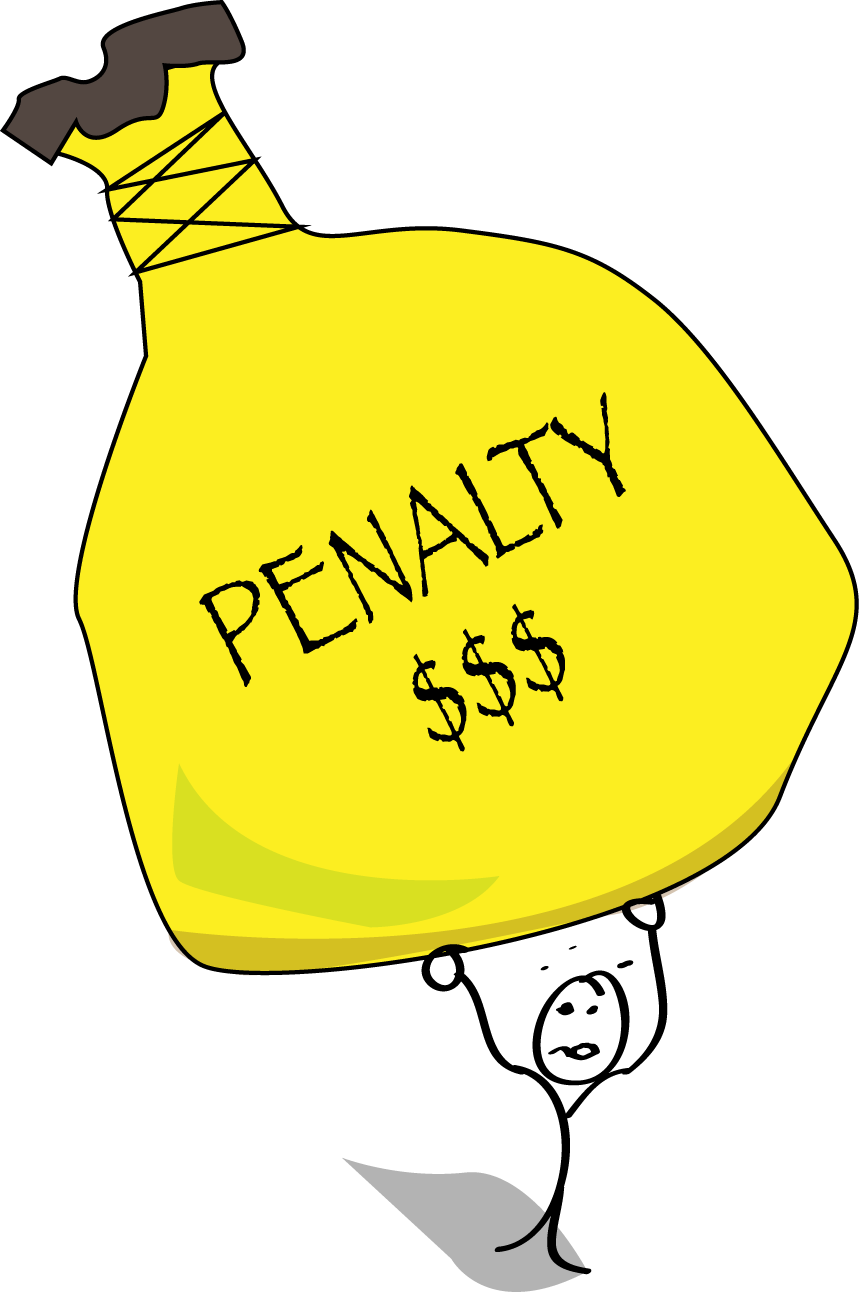Newsletter
Increase in the value of penalty units
- Tuesday, 01 January 2013 04:13
Higher financial penalties will soon be in place for breaches of most Australian Government laws. Several of the penalties administered by the ATO are calculated using penalty units rather than dollar figures or percentages of shortfall amounts. On 28 December 2012 the value of a penalty unit will increase from $110 to $170. 
For taxpayers, the implications of this legislative change are:
- administrative penalties that are calculated by the ATO using penalty units will be increased, and
- maximum available penalties for court-imposed fines will also rise.
The new penalty unit value will only apply to breaches that occur on or after 28 December 2012. This means that the changes will not impact on breaches that occur before 28 December 2012 or current proceedings for offences that were committed before this date.
The penalty unit value has not been adjusted since 1997. Under the new legislation, the value of the penalty unit will be reviewed every three years.
What can I claim as a small business?
- Tuesday, 01 January 2013 04:13
Three changes you might have missed to the simplified depreciation rules that apply to small businesses from the 2012-2013 income year:
1. INCREASE TO INSTANT ASSET WRITE-OFF THRESHOLD
You can now claim (write off) an outright deduction for most depreciating assets purchased that cost less than $6,500 each. This has increased from $1,000. 
Example:
Belinda buys a $5,500 camera and a $4,900 high resolution printer for her photography business. Both the camera and the printer are depreciating assets used entirely for business. As each cost less than $6,500, she can claim as a deduction $5,500 for the camera and $4,900 for the printer in the 2012-2013 income year.
2. ACCELERATED DEDUCTION FOR MOTOR VEHICLES
From 2012-2013 income year, if you buy a motor vehicle for use in your business, you can claim an immediate $5,000 deduction. The remainder of the cost is deducted through the general small business pool at 15% for the first year and 30% for later years. 
Example:
In the 2012-2013 income year Peter bought a $37,000 ute which was used 50% for business purposes. Louie calculates his depreciation deduction for the 2012-2013 income year this way:
$5,000 + 15% x ((50% x $37,000) - $5,000) = $7,025.
3. SIMPLIFIED POOLING
From 2012-2013, most depreciating assets that cost $6,500 or more (regardless of their effective life) can all be 'pooled' under the simplified depreciation rules and deducted at a single rate of 30%. The exception is newly acquired assets (like Peter’s ute) which are deducted at 15% (half the pool rate) for the first year.
If you had a long life pool (which no longer exists), its closing balance is rolled over to form part of the opening balance of the general pool for the 2012-2013 income year (to be depreciated at a rate of 30% instead of 5%).
Want to pay all your super contributions in one transaction?
- Tuesday, 01 January 2013 04:13
You can with the Small Business Superannuation Clearing House - a free online superannuation payments service that helps small businesses with 19 or fewer employees meet their superannuation guarantee obligations. 
Making superannuation contributions each quarter to numerous superannuation funds can be time consuming and can sometimes result in increased administrative costs.
The Small Business Superannuation Clearing House lets you pay your superannuation contributions in one transaction to a single location. It is designed to make this process easier, reducing red tape and compliance costs.
You simply register your employees’ superannuation fund details and they will distribute the contributions to the employees various superannuation funds.
For more information or you would like to use the service you can call 1300 660 048 or go to www.humanservices.gov.au.
Click on Business & employers, click on Employer resources and then click on Small Business Superannuation Clearing House.
Key Tax Dates
- Tuesday, 01 January 2013 04:13
15 JANUARY 2013
• Income tax return for taxable large/medium business taxpayers as per latest year lodged (all entities other than individuals) due date for lodging, unless required earlier. 
• Payment for companies and super funds was due 1 December 2012. Payment for trusts in this category is due as per their notice of assessment.
21 JANUARY 2013
• December 2012 monthly activity statement except for small business clients who report GST monthly and lodge electronically using a registered agent.
28 JANUARY 2013
• Super guarantee contributions for Quarter 2 (October – December 2012) are to be made to the fund by this date. Employers who do not pay minimum super contributions for Quarter 2 by this date must pay the super guarantee charge and lodge a Superannuation guarantee charge statement - quarterly (NAT 9599) with the ATO by 28 February 2013. Remember, the super guarantee charge is not tax deductible.
21 FEBRUARY 2013
• December 2012 monthly activity statement - due date for lodgement and payment.
• January 2013 monthly activity statement - due date for lodgement and payment.
28 FEBRUARY 2013
• Quarter 2 activity statements (October - December 2012) - due date for lodgement and payment (all lodgement methods).
• Income tax return for non-taxable large/medium business taxpayers as per latest year lodged (all entities other than individuals) due date for lodging.
• Income tax return for new registrant (taxable and non-taxable) SMSFs. If you have a newly registered self-managed super fund (SMSF), the Self-managed super fund annual return 2012 is due on this date. You need to ensure you leave enough time for the audit report to be completed to enable lodgement of the SMSF annual return by the due date.
• Annual GST return or information report if taxpayer does not have a tax return lodgement obligation (if taxpayer has a tax return obligation, this return/report must be lodged by the lodgement due date of the tax return).
• Superannuation guarantee charge (SGC) statement - quarterly and paying the super guarantee charge for Quarter 2 (October – December 2012), if the employer did not pay enough contributions on time.
21 MARCH 2013
• February 2013 monthly activity statement – due date for lodgement and payment.
Newsletter Signup
Receive FREE information and advice on Accounting & Taxation every Quarter
SignupArchive
- 4th Quarter 2024 (8)
- 3rd Quarter 2024 (9)
- 2nd Quarter 2024 (9)
- 1st Quarter 2024 (11)
- 4th Quarter 2023 (11)
- 3rd Quarter 2023 (9)
- 2nd Quarter 2023 (7)
- 1st Quarter 2023 (8)
- 4th Quarter 2022 (9)
- 3rd Quarter 2022 (8)
- 2nd Quarter 2022 (10)
- 1st Quarter 2022 (9)
- 4th Quarter 2021 (9)
- 3rd Quarter 2021 (8)
- 2nd Quarter 2021 (9)
- 1st Quarter 2021 (7)
- 4th Quarter 2020 (8)
- COVID-19 STIMULUS NEWSLETTER (8)
- 3rd Quarter 2020 (7)
- 2nd Quarter 2020 (9)
- 1st Quarter 2020 (9)
- 4th Quarter 2019 (8)
- 3rd Quarter 2019 (8)
- 2nd Quarter 2019 (7)
- 1st Quarter 2019 (8)
- 4th Quarter 2018 (7)
- 3rd Quarter 2018 (8)
- 2nd Quarter 2018 (8)
- 1st Quarter 2018 (8)
- 3rd Quarter 2017 (7)
- 2nd Quarter 2017 (7)
- 1st Quarter 2017 (7)
- 4th Quarter 2017 (8)
- 4th Quarter 2016 (7)
- 3rd Quater 2016 (7)
- 2nd Quater 2016 (7)
- 1st Quarter 2016 (8)
- 4th Quarter 2015 (6)
- 3rd Quarter 2015 (6)
- 2nd Quarter 2015 (8)
- 1st Quarter 2015 (6)
- 4th Quarter 2014 (7)
- 3rd Quarter 2014 (8)
- 2nd Quarter 2014 (7)
- 1st Quarter 2014 (8)
- 4th Quarter 2013 (7)
- 3rd Quarter 2013 (6)
- 2nd Quarter 2013 (9)
- 1st Quarter 2013 (8)